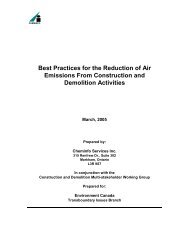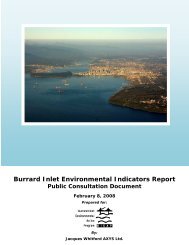burrard inlet environmental action program - the BIEAP and FREMP ...
burrard inlet environmental action program - the BIEAP and FREMP ...
burrard inlet environmental action program - the BIEAP and FREMP ...
Create successful ePaper yourself
Turn your PDF publications into a flip-book with our unique Google optimized e-Paper software.
<strong>BIEAP</strong> - Shoreline Development Guidelines<br />
Page 3 of 4<br />
should be incorporated into <strong>the</strong> shoreline wherever possible. Features should include<br />
gentle slopes (minimum 2:1 horizontal:vertical) faced with suitable materials, <strong>and</strong> benches<br />
or berms incorporated into <strong>the</strong> shoreline at appropriate tidal elevations. Alternative<br />
designs which may offer creative solutions to incorporating habitat features into <strong>the</strong><br />
shoreline should be pursued. Solid vertical faces (i.e. caissons, bulkheads, etc.) will not be<br />
suitable for habitat compensation.<br />
• Proposals for dredging should take into account existing habitat values <strong>and</strong> adverse<br />
impacts that might result from proposed dredging.<br />
Once <strong>the</strong> guiding principles have been applied to project design, consideration can be given to<br />
site specific measures <strong>and</strong> design details that will fur<strong>the</strong>r mitigate impacts on habitat, <strong>and</strong>, where<br />
applicable, appropriate measures to compensate for habitat losses. To allow for productive<br />
discussion of <strong>the</strong>se <strong>and</strong> related matters, <strong>and</strong> to enable BERC to properly assess <strong>the</strong> potential<br />
<strong>environmental</strong> impacts of a proposed development on a given site, it will be necessary for<br />
proponents to carry out detailed investigations, including field surveys, of current biological <strong>and</strong><br />
physical features of development sites. The level of detail required will depend to a significant<br />
degree upon <strong>the</strong> scale <strong>and</strong> complexity of <strong>the</strong> project <strong>and</strong> <strong>the</strong> extent of pre-existing knowledge of<br />
<strong>the</strong> project area from an <strong>environmental</strong> st<strong>and</strong>point. None<strong>the</strong>less, this information should be<br />
provided to BERC in advance of discussion of detailed project design.<br />
Biophysical surveys should be conducted by individuals suitably qualified in aquatic biology<br />
with a good underst<strong>and</strong>ing of marine biology <strong>and</strong> ecology, <strong>and</strong> demonstrated local experience in<br />
surveys of this kind. Knowledge of local fish <strong>and</strong> wildlife resources <strong>and</strong> <strong>the</strong>ir habitat<br />
requirements, <strong>and</strong> <strong>the</strong> concerns of BERC member agencies is essential. When planning <strong>and</strong><br />
conducting biophysical surveys, seasonal variation in community composition should be taken<br />
into account, <strong>and</strong> consideration should be given to conducting field surveys during periods of<br />
maximum production <strong>and</strong> diversity. Documentation of local biophysical features, including <strong>the</strong><br />
findings of field surveys should include maps or drawings of sufficient detail <strong>and</strong> in an<br />
appropriate scale to allow comparison with drawings of proposed shoreline alterations or inwater<br />
works, including dredging.<br />
The preceding comments focus primarily on concerns relating to fish habitat. Criteria relating to<br />
o<strong>the</strong>r concerns will also need to be addressed, including but not restricted to:<br />
• The impact of <strong>the</strong> project on migratory bird populations specifically those which currently<br />
use <strong>the</strong> site or which utilize areas adjacent to <strong>the</strong> site.<br />
• The impact of <strong>the</strong> project on habitat associated with significant adjacent shoreline features<br />
such as marshes, stream estuaries, riparian vegetation, cobble beaches, recreational areas,<br />
etc. For example, how will <strong>the</strong> existing hydrology <strong>and</strong> water quality of <strong>the</strong>se areas be<br />
affected?<br />
• The potential of <strong>the</strong> project to involve disturbance of contaminated soils or sediments on or<br />
adjacent to <strong>the</strong> Burrard Inlet shoreline (including areas of dredging), <strong>and</strong> consideration of<br />
options to appropriately manage <strong>the</strong>se materials.<br />
Latest Revision - June 5, 1996
















